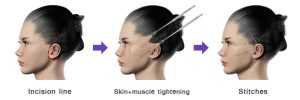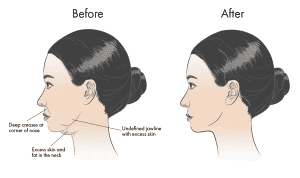Facelift Surgery in Turkey
A face-lift, or rhytidectomy, is a cosmetic surgical procedure that gives the face a more youthful appearance by reducing sagging skin and smoothing out folds on the cheeks and jawline. The surgeon lifts skin flaps on either side of the face, repositions underlying tissues, and trims away excess skin, resulting in a rejuvenated facial contour. Often, the surgeon performs a neck lift in conjunction with a face-lift to address fat accumulation and loose skin on the neck. However, the face-lift does not rectify skin damage caused by sun exposure, such as fine lines and wrinkles. Patients may require other cosmetic treatments to improve the skin’s texture and quality.
Purpose
The facial structure and appearance change with age due to factors such as decreased skin elasticity and the redistribution of fat deposits. A face-lift can help mitigate these aging effects by addressing:
- The sagging of the cheeks
- Excess skin along the jawline
- Pronounced folds of skin extending from the nose to the mouth
- Loose skin and excess fat in the neck (when combined with a neck lift)
While a face-lift can enhance the overall appearance by tightening sagging skin, it does not target fine wrinkles, sun damage, creases around the nose and upper lip, or uneven skin pigmentation. These concerns may require additional treatments to improve the skin’s overall appearance and texture.
Risks of Face-Lift Surgery
Undergoing a face-lift surgery comes with potential complications. While many issues can be addressed with proper care, medication, or additional surgery, some long-term or permanent complications could alter your appearance. Here are some risks associated with face-lift procedures:
- Hematoma: This is the most frequent complication, where a collection of blood forms under the skin, causing swelling and pressure. It typically develops within 24 hours after surgery. Prompt surgical intervention can prevent further damage to the skin and underlying tissues.
- Scarring: Although incision scars from a face-lift are permanent, they are usually concealed within the hairline and natural facial contours. In rare cases, incisions can lead to raised scars, which may be improved with corticosteroid injections or other treatments.
- Nerve Injury: Although rare, nerve injuries can occur, affecting sensation or muscle control. This can be temporary or permanent, leading to a loss of feeling or difficulty moving facial muscles, possibly resulting in an uneven facial expression. Surgical intervention might improve the situation.
- Hair Loss: Temporary or permanent hair loss can occur near incision sites. Permanent hair loss can be corrected with surgical procedures that transplant skin with hair follicles.
- Skin Loss: In rare cases, a face-lift can disrupt the blood supply to facial tissues, causing skin loss. This can be managed with medications and proper wound care, and additional procedures may be needed to minimize scarring.
with any major surgery
there are risks of bleeding, infection, and adverse reactions to anesthesia. Certain medical conditions or lifestyle habits may elevate the risk of complications. Factors that may contribute to unfavorable outcomes or increased risk include:
- Blood-thinning Medications or Supplements: Medications or supplements that thin the blood, such as blood thinners, aspirin, NSAIDs, ginseng, Ginkgo biloba, and fish oil, can impair clotting and raise the risk of hematomas post-surgery.
- Medical Conditions: Conditions that inhibit blood clotting or increase risks of poor healing, hematomas, or cardiac issues, such as uncontrolled diabetes and high blood pressure, may preclude face-lift surgery.
- Smoking: Smoking heightens the risk of poor healing, hematomas, and skin loss following a face-lift.
- Weight Changes: A history of significant weight fluctuations may affect long-term satisfaction with the surgery results, as these changes impact facial shape and skin condition.

Preparing for a Face-Lift
Initial Consultation with a Plastic Surgeon:
- Medical History and Examination: You’ll begin by discussing your past and present medical conditions with the plastic surgeon. This conversation should include any previous surgeries, particularly cosmetic ones, and any complications you might have encountered. Inform your surgeon about your smoking habits, and drug or alcohol use. The surgeon will likely conduct a physical examination and may ask for medical records from your healthcare provider. If there are any concerns regarding your eligibility for surgery, a specialist consultation might be necessary.
- Medication Review: Compile a list of all medications you regularly use, including their names and dosages. This list should cover prescription and non-prescription drugs, herbal remedies, vitamins, and dietary supplements.
- Facial Assessment: The plastic surgeon will take photographs of your face from various angles, along with close-ups of specific features. They will assess your bone structure, facial shape, fat distribution, and skin quality to determine the best surgical options for you.
- Discussing Expectations: You will talk about your goals for the face-lift. The surgeon will describe the changes you can anticipate and clarify what the procedure cannot achieve, such as eliminating fine wrinkles or correcting facial asymmetry.
Pre-Surgery Preparations:
- Medication Instructions: Follow guidelines on medications to discontinue before surgery and when to stop them. Typically, you’ll need to cease taking blood-thinning drugs and supplements at least two weeks prior. Confirm which medications are safe or if dosages should be adjusted.
- Face and Hair Washing: Expect to wash your face and hair with germicidal soap on the morning of your surgery.
- Fasting: Refrain from eating anything after midnight before the day of your surgery, although you may drink water and take approved medications.
- Arrange Post-Surgery Assistance: If your surgery is outpatient, ensure you have someone to drive you home and assist you on the first night post-procedure.
What to Expect
Surgeons can perform a face-lift in a hospital or an outpatient surgical center.
Before the Procedure:
Depending on your case, the surgeon might use local anesthesia with sedation, which numbs a specific part of the body, or general anesthesia, which induces a sleep-like state.
During the Face-Lift Procedure
A face-lift typically involves lifting the skin and tightening the underlying tissues and muscles to create a more youthful appearance. The surgeon may reshape, remove, or reposition fat in the face and neck. After re-draping the skin over the newly defined contours, they excise any excess skin and close the incision with stitches or surgical tape.
The type of incision used during the procedure in Turkey will depend on the techniques chosen and the patient’s preferences. The options include:
- Traditional Face-Lift Incision: This incision starts at the temples within the hairline, continues down and around the front of the ears, and ends in the lower scalp behind the ears. To enhance the neck’s appearance, an additional incision may be made under the chin.
- Limited Incision: A shorter incision that begins at the hairline above the ear and wraps around the front of the ear without extending into the lower scalp.
- Neck Lift Incision: This incision begins in front of the earlobe, circles around the ear, and extends into the lower scalp, with a small incision made under the chin to further refine the neck’s appearance.
A face-lift procedure in Turkey generally takes about 3 to 6 hours. However, if additional cosmetic procedures are performed simultaneously, the surgery may take longer.

After the Procedure
Post-surgery, you may experience:
- Mild to moderate discomfort
- Drainage from the incisions
- Swelling and bruising
- Numbness
Contact your doctor in Turkey immediately if you experience:
- Severe pain on one side of the face or neck within 24 hours post-surgery
- Chest pain
- Irregular heartbeats
The surgeon typically covers the incisions with bandages that apply gentle pressure to minimize swelling and bruising. They might also place a small tube beneath the skin behind one or both ears to drain any excess blood or fluid.
In the initial days following surgery in Turkey, doctors recommend:
- Rest with your head elevated
- Take prescribed pain medication as directed by your doctor
- Use cool packs on the face to alleviate pain and reduce swelling
Follow-Up Appointments in Turkey
After your face-lift surgery in Turkey, you will have a series of follow-up appointments over the next two months to ensure a smooth recovery:
- The Day After Surgery: The surgeon will likely remove the drainage tube and apply an antibiotic ointment to the incisions. New bandages will be placed on your face.
- Two to Three Days Post-Surgery: You may transition from wearing bandages to an elasticized facial sling for added support.
- One Week Post-Surgery: Your healthcare provider will remove the stitches and assess the healing of the wound.
- Ongoing Visits: The surgeon will schedule additional appointments to monitor your progress and address any concerns.
Self-Care Instructions at Home
During the first three weeks after your surgery in Turkey, following self-care instructions at home will aid in your recovery and minimize the risk of complications:
- Adhere to wound care instructions as directed by your surgeon in Turkey.
- Avoid picking at any crusting scabs that form on the wound.
- Follow guidelines on when and how to use shampoo and soaps, including recommended products.
- Wear clothes that fasten at the front and avoid garments that need to be pulled over your head.
- Minimize pressure or movement around the incision sites.
- Refrain from using makeup on your face.
- Avoid vigorous or aerobic activities and sports.
- Protect the incision from direct sun exposure for three weeks. Use a sunscreen with SPF 30 or higher thereafter.
- Avoid hair treatments such as coloring, bleaching, or perming for at least six weeks.
As you recover from your face-lift, you might choose to style your hair to conceal any signs of the incision. Consider postponing major social events for a couple of months to allow for optimal healing.
Results of a Face-Lift
A face-lift performed in Turkey can provide a more youthful appearance to your face and neck. However, the results are not permanent, and with time, the skin may begin to sag again. Generally, the effects of a face-lift can last about 10 years.


